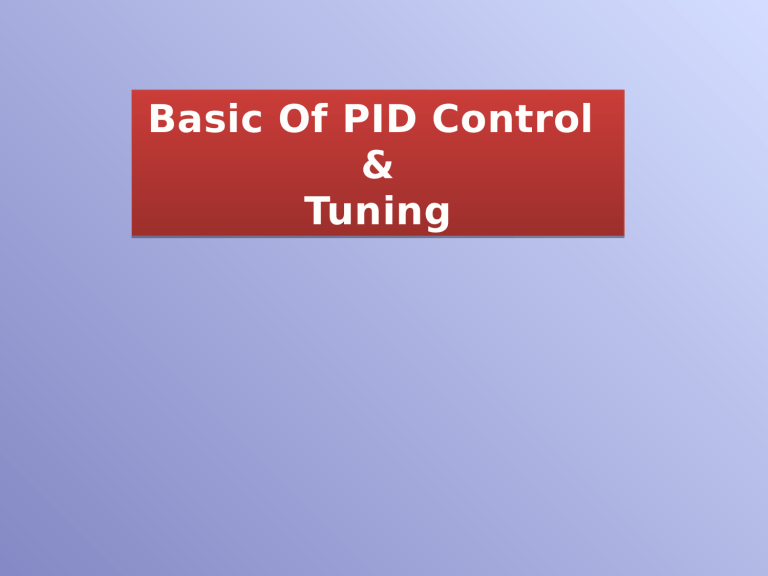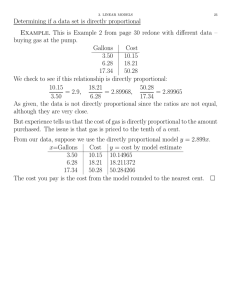
Basic Of PID Control & Tuning BASIC ON/OFF CONTROL Inflow START Qin L2 Solenoi d L1 S P P Qou t Solenoid power supply In On/Off control- control signal is either 0% or 100% Control at set point not achievable, a dead band must be incorporated Useful for large , sluggish system particularly those incorporating electric heaters Examples- Large tank level control - Lube oil tank temperature control by heaters BASIC PROPORTIONAL CONTROL V1 Qin 50% 60% Qo=50 Air to Close SP 50kPa 40kPa L T Qout 50t/h 60t/h 20-100 kPa Qo=60 P.C provides a control signal, proportional to the magnitude and direction of the error signal. After a disturbance, P.C will provide only a new mass balance situation. A change in control signal requires a change in error signal, therefore offset will occur. P.C stabilizes an error; it does not remove it TERMINOLOGY M=Measure signal k= gain SP=set point b=bias e(error)= SP - M m= controller signal output m=ke + b PB=proportional band Gain(k)= 100% PB Proportional band is defined as that input signal span change, in percent, which will cause a hundred percent change in output PRACTICAL PROPORTIONAL CONTROL V1 Qin 50% 60% 60 % LI C 50kPa L T 40kPa 45kPa 48kPa Qout 60t/h 50t/h Flow Change Kp= Air to Open 1 Kp= 2 Kp= 5 Kp 1 5 2 = 20-100 kPa Loss In Volume Higher PB Lower PB Outflow Inflow t0 t t0 t Level originally SP t1 New Level S Offset Offset t1 t1 New Level SP STEP CHANGE TIME WIDE PB OFFSET MODERATE PB NARROW PB SUMMARY & OPTIMUM PB Highly stable but sluggish system Fast acting system with large offset Unstable on/off system Require bias to avoid undesirable situation because m= ke, so m= ke + b Optimum setting for PB should result in the process decaying in a ¼ decay mode A A/4 A/16 RESET OF INTEGRAL ACTION To restore the process to the set point after disturbance then only proportional is insufficient The additional inflow must replace the lost volume Initial mass balance Reset action Loss in volume Outflow Inflow Set point Offset removed Additional Control signal restores process to set point PHENOMENA OF RESET ACTION Reset action is the Integration of the error signal to zero After time say ‘t’ reset action has repeated original proportional response , it is called repeat time R.A is defined as either reset rate in repeats per minute (RPM) or reset time in minutes per repeat (MPR) . MPR= 1/RPM Reset action will cause a ramping of the output signal to provide the necessary extra control action. st Fa se e R t r No t ese R l ma t Slow rese Ke Proportiona l Response Exam ple A direct acting controller has a proportional band of 50% is subjected to a sustained error. The set point is 50% and the measurement 55%. After 4 minutes the total output signal from the controller has increased by 30%. What is the reset rate setting in RPM and MPR? Soluti on PB = 50% Since ↑↑ k will be negative gain = 100% = 2 50% Proportional Signal = -2 x error = -2 x -5% +10% Total=signal after 4 minutes = +30% =P+I ∴Integral Signal = +20% i.e., integral action has repeated original proportional signal twice in 4 minutes, 1 repeats per 2 minutes or 0.5 repeats per minute. Reset rate = 0.5 RPM or 2 MPR SUMMAR Y Mathematical expression for integral action • • • • • m = control signal e = error signal (e = SP . M) ∴(+ or -) k = controller gain (↑↑ = −) (↑↓ = +) TR = reset time (MPR) b = bias signal Reset action removes offset If reset action is faster than the process can respond, Reset Windup can occur Reset Action makes a control loop less stable Do not subject process loops with reset control to sustained errors . the control signal will be ramped to the extreme value . reset windup will occur. DERIVATIVE ACTION The proportional mode considers the present state of the process error The integral mode looks at the past history of the error The derivative mode anticipates the future values of the error and acts on that prediction Derivative is related to the rate of change of the error signal and an anticipatory control, which provides a large initial control signal to limit the final deviation inpu t Proportiona l action outp ut Derivati ve action PHENOME NA Mathematical equation for PD controller • • • • • m = controller signal k = controller gain TD = derivative time e = error b = bias signal It should help reduce the time required to stabilize an error , derivative action ceases when the error stops changing. Its use, in practice, is also limited to slow acting processes. EXAMPL E Consider a simple flow control system B Proce ss Contr ol signa l A t Proportional 0 action A-B Rate action A-B C t 1 t 2 Tim e Rate action due to end of Rate increase in e action B-C Control signal at end of excursion Rate action due to end of increase in e Proportional action B-C SUMMA RY Derivative or rate action is anticipatory and will usually reduce, but not eliminate, offset. Its units are minutes (advance of proportional action). It tends to reduce lag in a control loop. Its use is generally limited to slow acting processes. PID Response PID Tuning The term tuning is used to describe methods used to select the best controller setting to obtain a particular form of performance. There are three methods that widely used for tuning 1. Process reaction method This method uses certain measurements made from testing the system with the control loop open so that no control action occurs. A test input signal is applied to the correction unit and the response of the controlled variable determined. Give step input as a test signal The graph of controlled variable is plotted against time Final value Maximum gradient line Measur ed Variabl e Original value Response of Controlled M variable Percentage change of the variable per minute L Start of test signal Tim e Criteria given by Ziegler and Nichols Type of controll er Kp P P/ML PI 0.9/ML Ti Td 3.3L The basis these criteria is 0.5L to give a closed-loop PID behind 1.2P/M 2L response for theLsystem which exhibits a quarter amplitude decay EXAMPLE 8 L = 5 min 0 0 5 10 15 M = 8/10 = 0.8 % / min Kp = 1.2P / ML = 1.2 X 10/0.8 X 5 =3 Ti = 2L = 10 min Td = 0.5L = 2.5 min 2. Ultimate cycle method 1. Set the controller to manual operation and the plant near to its normal operating conditions. 2. Turn off all control modes but proportional. 3. Set Kp to a low value, i.e. the proportional band to a wide value. 4. Switch the controller to automatic mode and then introduce a small set-point change, e.g. 5 to 10% and observe the response. 5. Set Kp to a slightly higher value, i.e. make the proportional band narrower. 6. Introduce a small set-point change, e.g. 5 to 10% and observe the response. 7. Keep on repeating 6 and 7 until the response shows sustained oscillations which neither grow nor decay. Note the value of Kp giving this condition (Kpu) and the period (Tu) of the oscillation. tu The Ziegler and Nichols criteria controller settings to have quarter amplitude decay is given by Table Type of controll er Kp Ti P 0.5 Kpu PI 0.45 Kpu Tu/1.2 PID 0.6 Kpu Tu/2 Td Tu/8 2. Quarter Amplitude Decay Control led variabl e The controller is set to proportional only With a step input to the control system, the output is monitored and amplitude decay is determined If the amplitude decay is greater than a quarter the proportional gain is increased If the amplitude decay is less than a quarter the proportional gain is decreased By method of trial & error the test input is repeated until a quarter wave amplitude decay is obtained Note this value of proportional gain The integral time constant is set to be T/1.5 The derivative time constant is T/6 Amplitude reduced by a quarter T Tim e Thank You!



